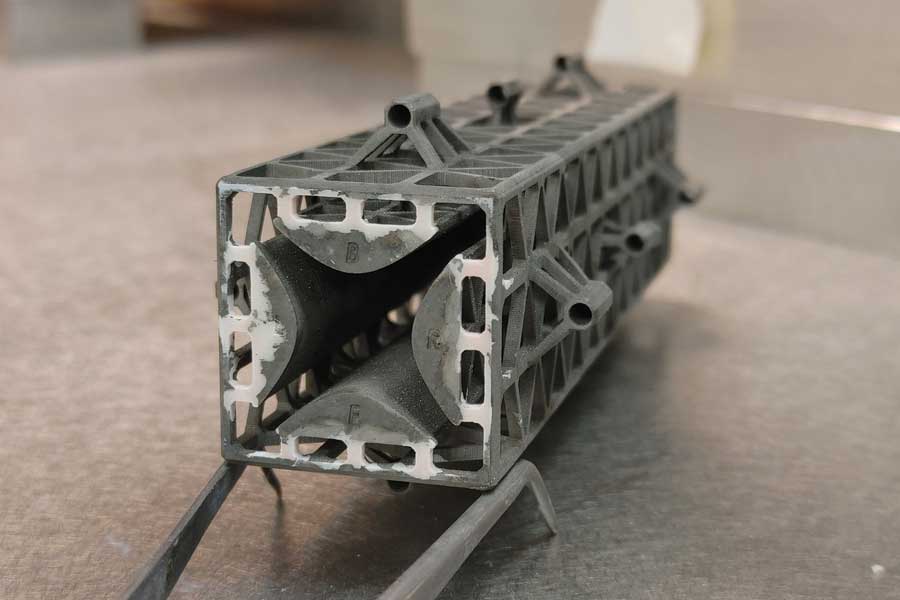Mass spectrometry (MS) is the gold standard for quantitative chemical analysis, profusely employed in fields such as healthcare, research, and defense. The heart of a mass spectrometer is the mass filter, which utilizes electromagnetic fields to sort ionized species in a vacuum based on their mass-to-charge ratio.
Nonetheless, mainstream mass spectrometers are large, expensive, heavy, and power-hungry, limiting their use in situ and in autonomous chemical analysis applications. Consequently, there is great interest in developing compact and capable mass spectrometers to address these drawbacks.
MIT scientists used additive manufacturing to produce a mass filter- the core component of a mass spectrometer. This newly created mass filter is extremely lightweight and cheaper than the previous filter. It is made of durable and heat-resistant glass-ceramic resin.
Scientists call their miniaturized filter a quadrupole. It is precise as some commercial-grade mass filters can cost over $100,000 and take weeks to manufacture.
Velásquez-García, a principal research scientist in MIT’s Microsystems Technology Laboratories (MTL) and senior author of a paper detailing the miniaturized quadrupole, said, “We are not the first ones to try to do this. But we are the first ones who succeeded at doing this. There are other miniaturized quadrupole filters, but they are not comparable with professional-grade mass filters. There are a lot of possibilities for this hardware if the size and cost could be smaller without adversely affecting the performance.”

A quadrupole, a common type of mass filter, is made up of four metallic rods surrounding an axis. Applying voltages to these rods generates an electromagnetic field. Depending on the field’s properties, ions with specific mass-to-charge ratios move through the filter’s center while others escape from the sides. Adjusting the voltage mix allows targeting ions with different mass-to-charge ratios.
Despite its simple design, a typical stainless-steel quadrupole is relatively heavy. Miniaturizing it is challenging, as smaller filters may introduce manufacturing errors and collect fewer ions, reducing chemical analysis sensitivity.
It is impossible to make quadrupoles arbitrarily smaller. There is a tradeoff.
The team addressed the tradeoff between size and sensitivity by utilizing additive manufacturing to create miniaturized quadrupoles with optimal dimensions for enhanced precision and sensitivity.
The filter is crafted from a glass-ceramic resin, a relatively new printable material that can withstand temperatures up to 900 degrees Celsius and perform effectively in a vacuum.
The device is manufactured through vat photopolymerization, a process involving a piston descending into a vat of liquid resin until it almost touches a set of LEDs at the bottom. Illuminating the LEDs cures the remaining resin in the narrow gap between the piston and the LEDs. This process repeats, gradually constructing the device one small layer at a time.
Velásquez-García said, “This is a relatively new technology for printing ceramics that allows you to make exact 3D objects. And one key advantage of additive manufacturing is that you can aggressively iterate the designs.”
Scientists harnessed the versatility of a 3D printer to design a quadrupole with hyperbolic rods, a shape ideal for mass filtering but challenging to create using traditional methods. Unlike many commercial filters with rounded rods that may diminish performance, the 3D-printed design enhances filtering capabilities.
In addition, an intricate network of triangular lattices surrounding the rods was printed to enhance durability and ensure proper rod positioning, even if the device is subjected to movement or shaking.
The final step involved electroless plating, a technique where the rods were coated with a thin metal film to make them electrically conductive. This process involved masking the entire device, except for the rods, and submerging the quadrupole in a precisely heated chemical bath with controlled stirring conditions. This ensured uniform deposition of a thin metal film on the rods without damaging the rest of the device or causing short circuits in the rods.
In testing the 3D-printed quadrupoles, the scientists substituted them into a commercial system and observed higher resolutions than other miniature filters. Despite being approximately 12 centimeters in length, their quadrupoles exhibit one-quarter the density of comparable stainless-steel filters.
Moreover, additional experiments indicate that the precision achieved by their 3D-printed quadrupoles is comparable to that of larger-scale commercial filters.
Graham Cooks, the Henry Bohn Hass Distinguished Professor of Chemistry in the Aston Laboratories for Mass Spectrometry at Purdue University, who was not involved with this work, said, “Mass spectrometry is one of the most important of all scientific tools, and Velásquez-Garcia and co-workers describe the design, construction, and performance of a quadrupole mass filter that has several advantages over earlier devices.”
“The advantages derive from these facts: It is much smaller and lighter than most commercial counterparts, and it is fabricated monolithically, using additive construction. … It is an open question as to how well the performance will compare with that of quadrupole ion traps, which depend on the same electric fields for mass measurement but do not have the stringent geometrical requirements of quadrupole mass filters.”
Steve Taylor, professor of electrical engineering and electronics at the University of Liverpool, who was also not involved with this paper, said, “This paper represents a real advance in the manufacture of quadrupole mass filters (QMF). The authors combine their knowledge of manufacture using advanced materials, QMF drive electronics, and mass spectrometry to produce a novel system with good performance at low cost.”
“Since QMFs are at the heart of the ‘analytical engine’ in many other types of mass spectrometry systems, the paper has an important significance across the whole mass spectrometry field, which represents a multibillion-dollar industry worldwide.”
In the future, scientists are planning to optimize the quadrupole’s performance by making the filters longer.
Journal Reference:
Colin C. Eckhoff, Nicholas K. Lubinsky, Luke J. Metzler et al. Low-Cost, Compact Quadrupole Mass Filters with Unity Mass Resolution via Ceramic Resin Vat Photopolymerization. Advanced Science. DOI: 10.1002/advs.202307665
>>> Read full article>>>
Copyright for syndicated content belongs to the linked Source : Tech Explorist – https://www.techexplorist.com/3d-printed-components-portable-mass-spectrometer/79321/










